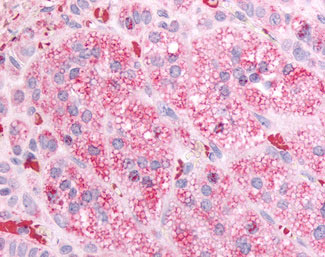GPR84 Antibody (Cytoplasmic Domain)
Rabbit Polyclonal Antibody
- SPECIFICATION
- CITATIONS
- PROTOCOLS
- BACKGROUND

Application
| IHC-P, E |
|---|---|
| Primary Accession | Q9NQS5 |
| Reactivity | Human |
| Host | Rabbit |
| Clonality | Polyclonal |
| Calculated MW | 44kDa |
| Dilution | IHC-P (10 µg/ml) |
| Gene ID | 53831 |
|---|---|
| Other Names | G-protein coupled receptor 84, Inflammation-related G-protein coupled receptor EX33, GPR84, EX33 |
| Target/Specificity | Human GPR84. BLAST analysis of the peptide immunogen showed no homology with other human proteins. |
| Reconstitution & Storage | Long term: -70°C; Short term: +4°C |
| Precautions | GPR84 Antibody (Cytoplasmic Domain) is for research use only and not for use in diagnostic or therapeutic procedures. |
| Name | GPR84 |
|---|---|
| Synonyms | EX33 |
| Function | G protein-coupled receptor that responds endogenously to dietary fatty acids or nutrient, specifically medium-chain free fatty acid (FFA) with carbon chain lengths of C9 to C14. Capric acid (C10:0), undecanoic acid (C11:0) and lauric acid (C12:0) are the most potent agonists (PubMed:16966319). In immune cells, functions as a pro- inflammatory receptor via 6-OAU and promotes the expression of pro- inflammatory mediators such as TNFalpha, IL-6 and IL-12B as well as stimulating chemotactic responses through activation of signaling mediators AKT, ERK and NF-kappa-B (By similarity). In addition, triggers increased bacterial adhesion and phagocytosis in macrophages and regulates pro-inflammatory function via enhancing NLRP3 inflammasome activation (By similarity). Also plays an important role in inflammation by modulating neutrophil functions (By similarity). Mechanistically, promotes neutrophil chemotaxis, reactive oxygen species (ROS) production and degranulation via LYN-AKT/ERK pathway (By similarity). To regulate ROS, communicates with the two formyl peptide receptors FPR2 and FPR1 to control the NADPH oxidase activity in neutrophils (PubMed:33789297). |
| Cellular Location | Cell membrane; Multi-pass membrane protein |
| Tissue Location | Expressed predominantly in hematopoietic tissues. High levels detected in the bone marrow and lower levels in the peripheral leukocytes and lung. Also expressed in brain, heart, muscle, colon, thymus, spleen, kidney, liver, placenta and intestine. Within the leukocyte population expression is higher in neutrophils and eosinophils relative to T- or B-lymphocytes |
| Volume | 50 µl |

Thousands of laboratories across the world have published research that depended on the performance of antibodies from Abcepta to advance their research. Check out links to articles that cite our products in major peer-reviewed journals, organized by research category.
info@abcepta.com, and receive a free "I Love Antibodies" mug.
Provided below are standard protocols that you may find useful for product applications.
Background
Receptor for medium-chain free fatty acid (FFA) with carbon chain lengths of C9 to C14. Capric acid (C10:0), undecanoic acid (C11:0) and lauric acid (C12:0) are the most potent agonists. Not activated by short-chain and long-chain saturated and unsaturated FFAs. Activation by medium-chain free fatty acid is coupled to a pertussis toxin sensitive G(i/o) protein pathway. May have important roles in processes from fatty acid metabolism to regulation of the immune system.
References
Yousefi S.,et al.J. Leukoc. Biol. 69:1045-1052(2001).
Wittenberger T.,et al.J. Mol. Biol. 307:799-813(2001).
Kaighin V.A.,et al.Submitted (OCT-2008) to the EMBL/GenBank/DDBJ databases.
Takeda S.,et al.FEBS Lett. 520:97-101(2002).
Mural R.J.,et al.Submitted (JUL-2005) to the EMBL/GenBank/DDBJ databases.
If you have used an Abcepta product and would like to share how it has performed, please click on the "Submit Review" button and provide the requested information. Our staff will examine and post your review and contact you if needed.
If you have any additional inquiries please email technical services at tech@abcepta.com.













 Foundational characteristics of cancer include proliferation, angiogenesis, migration, evasion of apoptosis, and cellular immortality. Find key markers for these cellular processes and antibodies to detect them.
Foundational characteristics of cancer include proliferation, angiogenesis, migration, evasion of apoptosis, and cellular immortality. Find key markers for these cellular processes and antibodies to detect them. The SUMOplot™ Analysis Program predicts and scores sumoylation sites in your protein. SUMOylation is a post-translational modification involved in various cellular processes, such as nuclear-cytosolic transport, transcriptional regulation, apoptosis, protein stability, response to stress, and progression through the cell cycle.
The SUMOplot™ Analysis Program predicts and scores sumoylation sites in your protein. SUMOylation is a post-translational modification involved in various cellular processes, such as nuclear-cytosolic transport, transcriptional regulation, apoptosis, protein stability, response to stress, and progression through the cell cycle. The Autophagy Receptor Motif Plotter predicts and scores autophagy receptor binding sites in your protein. Identifying proteins connected to this pathway is critical to understanding the role of autophagy in physiological as well as pathological processes such as development, differentiation, neurodegenerative diseases, stress, infection, and cancer.
The Autophagy Receptor Motif Plotter predicts and scores autophagy receptor binding sites in your protein. Identifying proteins connected to this pathway is critical to understanding the role of autophagy in physiological as well as pathological processes such as development, differentiation, neurodegenerative diseases, stress, infection, and cancer.


